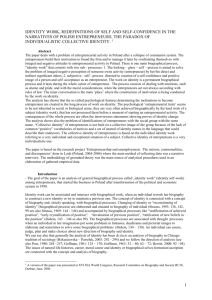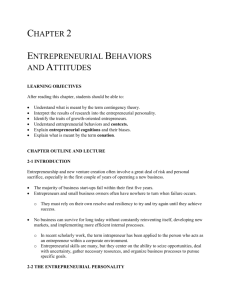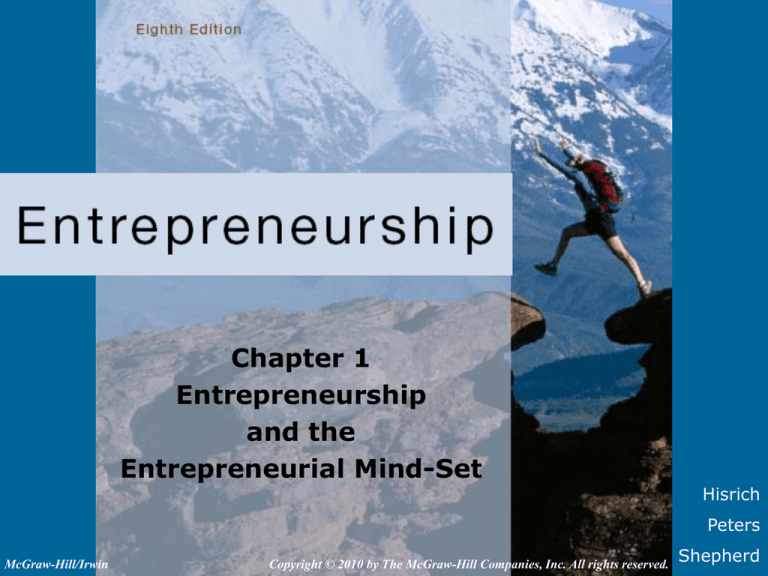
Chapter 1
Entrepreneurship
and the
Entrepreneurial Mind-Set
Hisrich
Peters
McGraw-Hill/Irwin
Copyright © 2010 by The McGraw-Hill Companies, Inc. All rights reserved.
Shepherd
Entrepreneur’s Adage #3
“When contemplating starting a business,
the first thing to consider is: How will this
business make my life EASIER? Starting a
business is difficult and takes everything
you’ve got. You need every advantage
possible.”
- Jordan
1-2
Nature and Development of
Entrepreneurship
Entrepreneur – An individual who takes
initiative to bundle resources in innovative
ways and is willing to bear the risk and/or
uncertainty to act.
From the French: “Entre” = betweeen,
“Prendre” = to take
1-3
The Entrepreneurial Process
Opportunity Identification - The process
by which an entrepreneur comes up with
the opportunity for a new venture.
Determine Market Size and
Characteristics/Segments
Window of Opportunity - The time period
available for creating the new venture.
Business Plan - The description of the
future direction of the business.
1-4
How Entrepreneurs Think
Entrepreneurs in particular situations may
think differently than others when faced
with a different task or decision
environment.
Given the nature of their decision-making
environment, entrepreneurs may need to:
Effectuate (see next slide)
Be cognitively adaptable.
Learn (quickly) from failure.
1-5
How Entrepreneurs Think
(cont.)
Effectuation processes
Starts with what one has (who they are, what
they know, and whom they know).
Make decisions based on one’s resources rather
than working backwards from goal.
Entrepreneurial mind-set involves the
ability to rapidly sense, act, and mobilize,
under (typically) uncertain conditions.
1-6
How Entrepreneurs Think
(cont.)
Cognitive Adaptability describes the
extent to which entrepreneurs are:
Dynamic, flexible, self-regulating and engaged
in the process of generating multiple decision
frameworks focused on sensing and processing
changes in their environments and then acting
on them.
Derives from an entrepreneur’s metacognitive awareness.
1-7
How Entrepreneurs Think
(cont.)
Achieving cognitive adaptability
Comprehension questions – Aids understanding of
the nature of the environment before addressing an
entrepreneurial challenge.
Connection tasks – Stimulates thinking about the
current situation in terms of similarities and differences
with situations previously faced and solved.
Strategic tasks – Stimulates thoughts about which
strategies are appropriate for solving the problem (and
why) or pursuing the opportunity (and how).
Reflection tasks – Stimulates thinking about their
understanding and feelings as they progress through
the entrepreneurial process.
1-8
How Entrepreneurs Think
(cont.)
Entrepreneurs with higher cognitive adaptability
are better able to:
Adapt to new situations.
Be creative.
Communicate their reasoning behind a particular
response.
Ultimately be successful in their entrepreneurial
venture.
1-9
How Entrepreneurs Think
(cont.)
An entrepreneur’s motivation is not simply to
make a (large) profit but also from:
Loyalty to a product.
Loyalty to a market and customers.
Personal growth.
The need to prove oneself.
The need to be independent (!!)
WHAT ARE YOUR ENTREPRENEURIAL
MOTIVATIONS?
1-10
Entrepreneur’s Adage #4
Before taking the plunge into a new venture, be
clear on what your personal and professional
motivations are for starting the business. Then
make sure that launching the business can
actually fulfill these motivations.
1-11
Why Some Businesses Fail
Goals are unreasonable.
Loss of key team member.
Entrepreneur has not made a total commitment to
the business.
Lack of experience in the planned business.
No sense of potential threats or weaknesses to the
business.
No real customer need was established for the
proposed product or service.
People management issues.
People and resources are stretched too thin.
1-12
How Entrepreneurs Think
(cont.)
Learning from Business Failure
Loss of a business can result in a negative
emotional response from the entrepreneur.
It can interfere with:
Entrepreneur’s ability to learn from the failure.
Motivation to try again.
1-13
How Entrepreneurs Think
(cont.)
Recovery and Learning Process
Emotional Recovery from failure happens
when thoughts about the events surrounding,
and leading up to the loss of the business, no
longer generate a negative emotional response.
Recovery is achieved through:
Loss-orientation.
Restoration-orientation.
1-14
How Entrepreneurs Think
(cont.)
Loss-Orientation
Involves working through, and processing, some
aspect of the loss experience and, as a result of this
process, breaking emotional bonds to the object lost.
This process gradually provides meaning for the loss
and eventually produces a changed viewpoint.
Involves confrontation, which is physically and
mentally exhausting.
Characterized by feelings of relief and pain that wax
and wane over time.
1-15
How Entrepreneurs Think
(cont.)
Restoration-Orientation
Based on both avoidance and a proactiveness toward
secondary sources of stress arising from a major loss.
Involves suppression of direct thoughts about the loss,
which requires sustained mental effort
May reduce emotional significance of the loss.
1-16
How Entrepreneurs Think
(cont.)
A Dual Process for Learning from Failure
The dual process of oscillating between the lossorientation and restoration-orientation enables a
person to:
Obtain the benefits of each.
Minimize the costs of maintaining one for too long.
This dual process speeds the recovery process.
1-17
Entrepreneur’s Adage #5
“Don’t expect others to be excited about
your business ideas or even like them.
Stop seeking acceptance from everyone
around you. All that matters is acceptance
from the “right” people including, of course,
customers.”
- Jordan
1-18



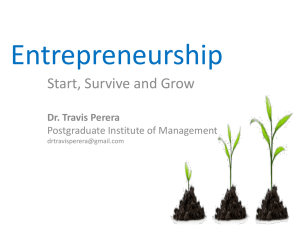

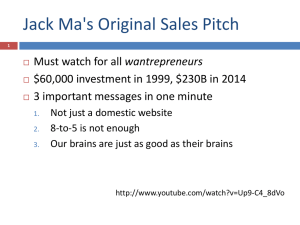

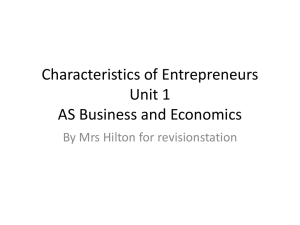

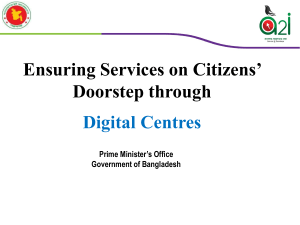
![[01]. Entrepreneurship and the Entrepreneurial Mind-Set](http://s2.studylib.net/store/data/005488085_2-146a4b12485f0514f12623d59566b5e3-300x300.png)
